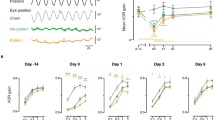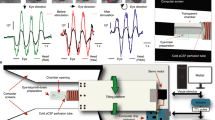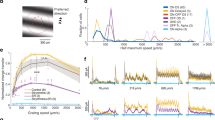Abstract
The vestibulo-ocular reflex (VOR) is classically associated with stabilizing the visual world on the retina by producing an eye movement of equal and opposite amplitude to the motion of the head. Here we have directly measured the efficacy of VOR pathways during voluntary combined eye–head gaze shifts by recording from individual vestibular neurons in monkeys whose heads were unrestrained. We found that the head-velocity signal carried by VOR pathways is reduced during gaze shifts in an amplitude-dependent manner, consistent with results from behavioral studies in humans and monkeys. Our data support the hypothesis that the VOR is not a hard-wired reflex, but rather a pathway that is modulated in a manner that depends on the current gaze strategy.
This is a preview of subscription content, access via your institution
Access options
Subscribe to this journal
Receive 12 print issues and online access
$209.00 per year
only $17.42 per issue
Buy this article
- Purchase on Springer Link
- Instant access to full article PDF
Prices may be subject to local taxes which are calculated during checkout





Similar content being viewed by others
References
Grossman, G. E., Leigh, R. J., Abel, L. A., Lanska, D. J. & Thurston, S. E. Frequency and velocity of rotational head perturbations during locomotion. Exp. Brain Res. 70, 470–476 (1988).
Grossman, G. E., Leigh, R. J., Bruce, E. N., Huebner, W. P. & Lanska, D. J. Performance of human vestibuloocular reflex during locomotion. J. Neurophysiol. 62, 264–271 (1989).
André-Deshays, C., Berthoz, A. & Revel, M. Eye-head coupling in humans. I. Simultaneous recording of isolated motor units in dorsal neck muscles and horizontal eye movements. Exp. Brain Res. 69, 399– 406 (1988).
Barnes, G. R. Vestibulo-ocular function during co-ordinated head and eye movements to acquire visual targets. J. Physiol. 287, 127– 147 (1979).
Guitton, D. & Volle, M. Gaze control in humans: eye-head coordination during orienting movements to targets within and beyond the oculomotor range. J. Neurophysiol. 58, 427– 459 (1987).
Laurutis, V. P. & Robinson, D. A. The vestibulo-ocular reflex during human saccadic eye movements. J. Physiol. 373, 209–233 (1986).
Pélisson, D., Prablanc, C. & Urquizar, C. Vestibulo-ocular reflex inhibition and gaze saccade control characteristics during eye-head orientation in humans. J. Neurophysiol. 59, 997–1013 (1988).
Zangemeister, W. H. & Stark, L. Gaze latency: variable interactions of head and eye latency. Exp. Neurol. 75, 389–406 (1982).
Zangemeister, W. H. & Stark, L. Types of gaze movement: variable interactions of eye and head movements. Exp. Neurol. 77, 563–577 (1982).
Bizzi, E., Kalil, R. E. & Tagliasco, V. Eye-head coordination in monkeys: evidence for centrally patterned organization. Science 173, 452 –454 (1971).
Dichgans, J., Bizzi, E., Morasso, P. & Tagliasco, V. Mechanisms underlying recovery of eye-head coordination following bilateral labyrinthectomy in monkeys. Exp. Brain Res. 18, 548– 562 (1973).
Morasso, P., Bizzi, E. & Dichgans, J. Adjustment of saccade characteristics during head movements. Exp. Brain Res. 16, 492– 500 (1973).
Tomlinson, R. D. Combined eye-head gaze shifts in the primate. III. Contributions to the accuracy of gaze saccades. J. Neurophysiol. 64, 1873 –1891 (1990).
Tomlinson, R. D. & Bahra, P. S. Combined eye-head gaze shifts in the primate. I. Metrics. J. Neurophysiol. 56, 1542–1557 (1986).
Tomlinson, R. D. & Bahra, P. S. Combined eye-head gaze shifts in the primate. II. Interactions between saccades and the vestibulo-ocular reflex. J. Neurophysiol. 56, 1558– 1570 (1986).
Lefèvre, P., Bottemanne, I. & Roucoux, A. Experimental study and modeling of vestibulo-ocular reflex modulation during large shifts of gaze in humans. Exp. Brain Res. 91, 496–508 ( 1992).
Pélisson, D. & Prablanc, C. Vestibulo-ocular reflex (VOR) induced by passive head rotation and goal-directed saccadic eye movements do not simply add in man. Brain Res. 380, 397–400 (1986).
Tabak, S., Smeets J. B. J. & Collewijn, H. Modulation of the human vestibuloocular reflex during saccades: probing by high-frequency oscillation and torque pulses of the head. J. Neurophysiol. 76, 3249– 3263 (1996).
Lorente De No', R. Vestibular-ocular reflex arc. Arch. Neurol. Psychiatry 30, 245–291 (1933).
Cullen, K. E. & McCrea, R. A. Firing behavior of brain stem neurons during voluntary cancellation of the horizontal vestibuloocular reflex I. secondary vestibular neurons. J Neurophysiol. 70 , 828–843 (1993).
Cullen, K. E., Chen-Huang, C. & McCrea, R. A. Firing behavior of brainstem neurons during voluntary cancellation of the horizontal vestibulo-ocular reflex. II. eye-movement related neurons. J. Neurophysiol. 70, 844– 856 (1993).
Fuchs, A. F. & Kimm, J. Unit activity in vestibular nucleus of the alert monkey during horizontal angular acceleration and eye movement. J. Neurophysiol. 38, 1140– 1161 (1975).
Keller, E. L. & Daniels, P. Oculomotor related interaction of vestibular and visual stimulation in vestibular nucleus cells in the alert monkey. Exp. Neurol. 46, 187– 198 (1975).
King, W. M., Lisberger, S. G. & Fuchs, A. F. Responses of fibers in medial longitudinal fasciculus (MLF) of alert monkeys during horizontal and vertical conjugate eye movements evoked by vestibular or visual stimuli. J. Neurophysiol. 39, 1135–1149 (1976).
Lisberger, S. G. & Miles, F. A. Role of the primate vestibular nucleus in long-term adaptive plasticity of the vestibulo-ocular reflex. J. Neurophysiol. 43, 1725– 1745 (1980).
McCrea, R. A., Strassman, E. M. & Highstein, S. M. Anatomical and physiological characteristics of vestibular neurons mediating the horizontal vestibulo-ocular reflex of the squirrel monkey. J. Comp. Neurol. 264, 547– 570 (1987).
McFarland, J. L. & Fuchs, A. F. Discharge patterns of nucleus prepositus hypoglossi and adjacent vestibular nucleus during horizontal eye movement in behaving macaques. J. Neurophysiol. 41, 319–332 (1992).
Scudder, C. A. & Fuchs, A. F. Physiological and behavioural identification of vestibular nucleus neurons mediating the horizontal vestibuloocular reflex in trained rhesus monkeys. J. Neurophysiol. 68, 244–264 (1992).
McCrea, R. A., Chen-Huang, C., Belton, T. & Gdowski, G. T. Behavior contingent processing of vestibular sensory signals in the vestibular nuclei. Ann. NY Acad. Sci. 781, 292– 303 (1996).
Cullen, K. E. & Guitton, D. Analysis of primate IBN spike trains using system identification techniques. II. relationship to gaze, eye, and head movement dynamics during head-free gaze shifts. J. Neurophysiol . 78, 3283–3306 ( 1997).
Freedman, E. G. & Sparks, D. L. Eye-head coordination during head-unrestrained gaze shifts in rhesus monkeys. J. Neurophysiol. 77, 2328–2348 ( 1997).
Phillips, J. O., Ling, L., Siebold, C. & Fuchs, A. F. Behavior of primate vestibulo-ocular reflex neurons and vestibular neurons during head-free gaze shifts. Ann. NY Acad. Sci. 781, 276– 291 (1996).
Hikosaka, O. & Kawakami, T. Inhibitory neurons related to the quick phase of vestibular nystagmus - their location and projections. Exp. Brain Res. 27, 377–396 (1977).
Hikosaka, O., Igusa, Y., Nakao, S. & Shimazu, H. Direct inhibitory synaptic linkage of pontomedullary reticular burst neurons with abducens motoneurons in the cat. Exp. Brain Res. 33, 337– 352 (1978).
Igusa, Y., Sasaki, S. & Shimazu, H. Excitatory premotor burst neurons in the cat pontine reticular formation related to the quick phase of vestibular nystagmus. Brain Res. 182, 451–456 (1980).
Sasaki, S. & Shimazu, H. Reticulovestibular organization participating in generation of horizontal fast eye movement. Ann. NY Acad. Sci. 374, 130–145 (1981).
Scudder, C. A., Fuchs, A. F. & Langer, T. P. Characteristics and functional identification of saccadic inhibitory burst neurons in the alert monkey. J. Neurophysiol . 59, 1430–1454 ( 1988).
Strassman, A., Highstein, S. M. & McCrea, R. A. Anatomy and physiology of saccadic burst neurons in the alert squirrel monkey. I. Excitatory burst neurons. J. Comp. Neurol. 249, 337–357 ( 1986).
Strassman, A., Highstein, S. M. & McCrea, R. A. Anatomy and physiology of saccadic burst neurons in the alert squirrel monkey. II. Inhibitory burst neurons. J. Comp. Neurol. 249, 358–380 (1986).
Yoshida, K., Berthoz, A., Vidal, P. P. & McCrea, R. A. Morphological and physiological characteristics of inhibitory burst neurons controlling rapid eye movements on the alert cat. J. Neurophysiol . 48, 761–784 ( 1982).
Nakao, S., Sasaki, S., Schor, R. H. & Shimazu, H. Functional organization of premotor neurons in the cat medial vestibular nucleus related to slow and fast phases of nystagmus. Exp. Brain Res. 45, 371–385 (1982).
Hays, A. V., Richmond, B. J. & Optican, L. M. A UNIX-based multiple process system for real-time data acquisition and control. W ESCOM Conf. Proc. 2 , 1–10 (1982).
Cullen, K. E., Rey, C. G., Guitton, D. & Galiana, H. L. The use of system identification techniques in the analysis of oculomotor burst neuron spike train dynamics. J. Comput. Neurosci. 3, 347–368 (1996).
Acknowledgements
We thank D. Guitton for discussions and comments on the manuscript, P. A. Sylvestre and G. A. Wellenius for critically reading the manuscript and W. Kucharski and A. Smith for technical assistance. This study was supported by the Medical Research Council of Canada (MRC).
Author information
Authors and Affiliations
Corresponding author
Rights and permissions
About this article
Cite this article
Roy, J., Cullen, K. A neural correlate for vestibulo-ocular reflex suppression during voluntary eye–head gaze shifts. Nat Neurosci 1, 404–410 (1998). https://doi.org/10.1038/1619
Received:
Accepted:
Issue Date:
DOI: https://doi.org/10.1038/1619
This article is cited by
-
Context-independent encoding of passive and active self-motion in vestibular afferent fibers during locomotion in primates
Nature Communications (2022)
-
Nystagmus only with fixation in the light: a rare central sign due to cerebellar malfunction
Journal of Neurology (2022)
-
Influence of predictability on saccade timing in a head impulse VOR suppression task
Experimental Brain Research (2022)
-
Vestibular processing during natural self-motion: implications for perception and action
Nature Reviews Neuroscience (2019)
-
Enhanced vestibulo-ocular reflex suppression in dancers during passive high-velocity head impulses
Experimental Brain Research (2019)



